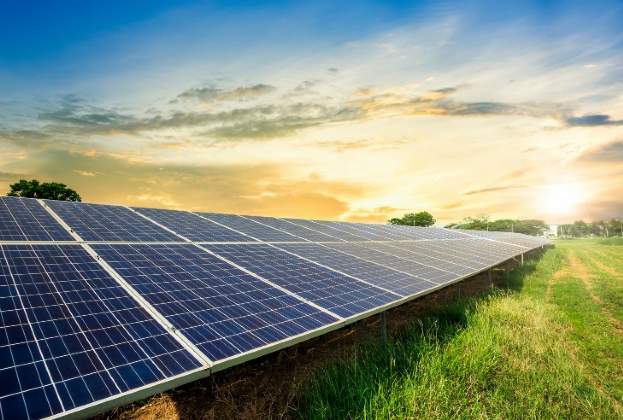The sun is the ultimate source of almost all the energy used on earth, and trapping that energy is cheaper and more efficient than ever before. Solar is the fastest-growing form of renewable energy, and real estate can play a significant part in that growth story.
Cheaper, more efficient solar panels and the modular nature of energy production makes solar power the perfect fit for real estate, allowing the sector to evolve and embrace solar’s huge potential.
The International Energy Agency (IEA) forecasts renewables will overtake fossil fuels and nuclear in electricity generation by 2026. It predicts solar will show the strongest growth over the next two decades.
Thomas McMillan, Head of Energy Consulting at Savills, says: “Every day we get enough energy from the sun to power our planet for 27 years. Solar alone has the potential to reduce global carbon emissions by up to 25% by 2050 and it’s a technology that works today.”
The case for Solar in the Middle East
Seasonality of sunshine is an obstacle for solar in temperate climates. However, the sunny climate of the Middle East is driving substantial investment in solar, says Stuart Healey, Commercial Director, Building & Projects Consultancy, Savills Dubai. “The region is leading on various fronts, such as hosting the largest single site solar park at Mohammed Bin Rashid Al Maktoum Solar Park in Dubai; investing USD 50 billion into renewable energy by 2023 in Saudi Arabia; and setting ambitious targets, such as the Egyptian government’s plan to obtain 42% of the country’s electricity from renewables by 2034.”
Why solar works for real estate
Investors in solar energy production face upfront costs for systems and installation, but minimal ongoing costs, while maintenance is simple and relatively cheap: a broken panel is easy to replace and does not bring the whole system down.
The modular nature of solar makes it “the perfect fit for real estate,” says McMillan. “It can be installed on a roof or a canopy over a car park, allowing asset owners to generate their own electricity.” Solar panels are installed on buildings as diverse as the Burj Khalifa in Dubai, the White House in Washington, DC, and the ‘Sundial building’ in Dezhou, China, a conference and exhibition center with 5,000 sq m of solar cells on its roof.
Commercial real estate owners who install solar can benefit from lower electricity costs. The Solar Energy Industries Association estimates an average US office building could save 20-40% on its annual energy bill from installing solar panels.
The use of renewables can contribute to company ESG goals or to meeting the requirements of green legislation. Asset owners can also potentially sell surplus power back to the grid. The millions of dwellings in the residential sector provide a significant opportunity for solar. For homeowners, the main obstacles are the cost of retrofitting and the appearance of the panels. However, developers are fitting solar panels on many new homes in Europe and roof-integrated panels are less obtrusive.
The impact of supply chains
According to a recent report by the International Energy Agency, “China’s share in all the key manufacturing stages of solar panels exceeds 80% today, and for key elements this is expected to rise to over 95% in the coming years, based on current manufacturing capacity under construction.”
IEA found that high commodity prices and existing bottlenecks in the supply chain had already contributed to an increase of 20% in panel prices over the last year, and had delayed deliveries of materials around the world.
The organisation is therefore stressing on governments to adopt diversification strategies to avoid over-reliance on a single geography for the supply of key materials. This diversification is essential to ensure a secure transition to net zero emissions by 2050.
Tomorrow’s target: Panels on every roof
According to Stuart Elmes Chief Executive Office at Viridian Solar:
“The story of solar in the past decade has been that of price reductions achieved through technological development and economies of scale. As cell efficiency has improved as well, the power capacity of a panel has risen by a third in the past five years. Work is underway on new tech which could boost that by a further 50% in the future.
Over the next decade, the big story will be the partner technologies that are enablers for solar power.
Battery storage is the obvious one; most people who add solar to their own homes now include battery storage. Another is smart energy grids, where price signals are used to align consumption to availability. These work alongside smart devices, such as fridges that can regulate how hard they run, depending on the electricity price.
Declining battery costs mean the payback for installing our panels is now around eight years and falling.
In 2050, good for the solar industry will mean panels on every roof.
Where is Egypt on Renewable Energy?
Egypt has set renewable energy targets of 20% of the electricity mix by 2022 and 42% by 2035.
Renewable energy plays a central role detailed in Egypt’s energy diversification strategy to 2035, called the Integrated Sustainable Energy Strategy. The Ministry of Electricity and Renewable Energy has set renewable energy targets of 20% of the electricity mix by 2022 and 42% by 2035. The feed-in-tariff programme initiated by Egypt in 2015 has attracted investments in large scale solar and wind energy projects.
The Energy Efficiency Project
With financing from the Global Environment Facility (GEF), the United Nations Development Programme (UNDP) initiated a comprehensive programme with the Ministry of Electricity and Renewable Energy to help Egyptians embrace energy efficient appliances and lighting systems. The project catalysed large-scale transformation to energy efficient lighting systems in Egypt:
- 200 million LED Lamps connected to the grid for buildings in different sectors.
- 20,177 GWh Annual Energy Savings.
- 12.8 % Reduction in Fuel consumption rate nationwide in power stations since 2015.
- 2.7 million LED street lighting fixtures since 2015.
- 1.5 billion USD Investments in LED lighting
Large scale renewables
The total installed capacity for Photovoltaic (PV) systems for electricity generation is 1.49 GW including Egypt’s solar power complex in Benban, located near Aswan, the largest solar park in Africa and is set to become the largest in the world. The project has been recognised internationally as a large-scale model for reducing carbon emissions.
- 5.9 GW of solar, wind and hydro renewable energy capacities installed.
- 3 GW of renewable energy capacities under development.
- 24.98 TWh of electricity is generated per year from renewable energy
- 42% from total electricity generation from solar, wind and hydro in 2035
Small scale renewables
The Grid-Connected Small Scale Photovoltaic Systems “Egypt-PV”, implemented by the UNDP in partnership with the Industrial Modernization Center (IMC), Ministry of Trade and Industry and funded by the Global Environment Facility (GEF), is a project that emphasises the development of decentralised, grid-connected small-scale PV systems. Small scale solar power stations can be seen today in cities at the rooftop of schools, supermarkets, car parks, hotels, and government buildings. A total of 100 MW of small-scale solar power systems connected to the grid since 2018.
.jpg)

-(1)(1)(1).jpg)

.jpg)


.jpg)